Detection of Aguadas (Ponds) Through Remote Sensing in the Bajo El Laberinto Region, Calakmul, Campeche, Mexico
Abstract
Highlights
- Lidar-derived Digital Elevation Models and Infrared high-definition imagery from satellites constitute the most efficient tools for identifying aguadas (ponds) in regions covered by dense forest.
- Three hundred fifty aguadas were identified in the Calakmul Biosphere Reserve.
- Lidar-derived Digital Elevation Model and Infrared high-definition satellite images and supplementary sources can be combined to enhance the identification of minor water bodies in densely wooded regions.
- Ponds in the Calakmul Biosphere Reserve exceed the number that has previously documented, and their identification is highly relevant for conservation and archeological studies.
Abstract
1. Introduction
1.1. The Bajo El Laberinto Region and Its Significance in Maya History
1.1.1. Overview of the Yaxnohcah-Pared De Los Reyes Area
1.1.2. Overview of the Calakmul Area
1.2. Aguadas: Primary Characteristics and Definitions
1.3. Location of Aguadas and Remote Sensing
2. Materials and Methods
2.1. Lidar DEM and Visualization Techniques
2.2. Orthophotos Derived from Aerial Photographs
2.3. Satellite Images and Visualization Techniques
RGB Mosaic Images from Web Platforms
2.4. Multispectral Imagery
2.5. Identification Procedure
2.6. Visualization Comparison
3. Results
3.1. Characteristics and Variability of Aguadas
- Spatial resolution is crucial for identifying aguadas, as a higher resolution enhances the visibility of surface details, facilitating the detection of even the smallest examples;
- Identification of aguadas depends primarily on the type of vegetation and whether it has canopy cover or not. Open canopy aguadas are the easiest to identify, and we assume that we have recorded all features with these characteristics;
- Lidar-derived DEM SLRM and VAT visualizations are the most efficient, facilitating the identification of a total of 99 aguadas;
- Out of the included satellite imagery sources, near-infrared (NIR) imagery from Planet has the highest success rate for aguada identification (74) due to the reflectivity of water;
- The orthophotos from INEGI, despite their great spatial resolution of 1.5 m, yield worse results compared to multispectral images, as they offer just a monochromatic representation of the surface. Nonetheless, despite these constraints, about 60% of the aguadas were identified, surpassing the web mosaics;
- Bing is the most efficient among the images retrieved from web platforms, followed by ESRI, while Google Earth is the least effective due to its low spatial resolution in the survey area;
3.2. Field Verification
3.3. Application of the Identification Process to the Entire Bajo El Laberinto Region
4. Discussion
5. Conclusions
Supplementary Materials
Author Contributions
Funding
Data Availability Statement
Acknowledgments
Conflicts of Interest
Abbreviations
| CBR | Calakmul Biosphere Reserve |
| DEM | Digital Elevation Model |
| EIR | Elevated Interior Region |
| PABEL | Proyecto Arqueológico Bajo El Laberinto |
| PAY | Proyecto Arqueológico Yaxnohcah |
| GIS | Geographic Information System |
| RGB | Red, Green, Blue |
| NIR | Near Infrared |
| VNIR | Visible Near Infrared |
| SWIR | Short Wave Infrared |
| SLRM | Simple Local relief Model |
| VAT | Visualization for Archaeological Topography |
| RVT | Relief Visualization Toolbox |
| INEGI | Mexican Institute of Geography and Statistics. |
| CONABIO | National Commission for the Knowledge and Use of Biodiversity of Mexico |
References
- Dunning, N.P.; Beach, T.P.; Luzzadder-Beach, S. Kax and Kol: Collapse and Resilience in Lowland Maya Civilization. Proc. Natl. Acad. Sci. USA 2012, 109, 3652–3657. [Google Scholar] [CrossRef] [PubMed]
- Reyna-Hurtado, R.A.; Anleu, R.G.; Vetorazzi, M.G.; Pinzón, K.S.; Slater, K.; Nobrega, J.B.; Contreras, F.; Martin, G.M.S.; Panti, D.S.; Martínez, W.; et al. Aguadas de la Selva Maya: Santuarios de vida silvestre que unen esfuerzos de conservación internacional. Cienc. Nicolaita 2022, 84, 71–80. [Google Scholar] [CrossRef]
- Serrano-Mac-Gregor, I.; Weston-Flores, M. Las Aguadas de Calakmul y El Cambio Climático: ¿Qué Son Las Aguadas? Cienc. Y Mar 2021, XXV, 95–100. [Google Scholar]
- Slater, K. Calakmul Biodiversity Monitoring Report 2014–2019; Operation Wallacea: Old Bolingbroke, UK, 2021. [Google Scholar]
- García Gil, G.; Palacio Prieto, J.L.; Ortiz Pérez, M.A. Reconocimiento geomorfológico e hidrográfico de la Reserva de la Biosfera Calakmul, Mexico. Investig. Geográficas 2002, 48, 7–23. [Google Scholar]
- Dunning, N.P.; Beach, T.; Luzzadder-Beach, S. Environmental Variability among Bajos in the Southern Maya Lowlands and Its Implications for Ancient Maya Civilization and Archaeology; University of Arizona Press: Tucson, AZ, USA, 2006; pp. 81–99. [Google Scholar]
- Dunning, N.P.; Lentz, D.L.; Scarborough, V.L. Tikal Land, Water, and Forest: An Introduction. In Tikal: Paleoecology of an Ancient Maya City; Cambridge University Press: Cambridge, UK, 2015; pp. 1–15. [Google Scholar]
- Wahl, D.; Schreiner, T.; Byrne, R.; Hansen, R. A Paleoecological Record from a Late Classic Maya Reservoir in the North Petén. Lat. Am. Antiq. 2007, 18, 212–222. [Google Scholar] [CrossRef]
- Hubp, J.L. Elementos de Geomorfología Aplicada; Universidad Nacional Autónoma de Mexico: Mexico City, Mexico, 1988; ISBN 978-968-36-0560-3. [Google Scholar]
- Hubp, J.L. Diccionario Geomorfológico; Instituto de Geografía: Rio de Janeiro, Brazil, 2011; ISBN 978-607-02-2707-3. [Google Scholar]
- Nicod, J. A Little Contribution to the Karst Terminology: Special or Aberrant Cases of Poljes? Acta Carsologica 2003, 32, 29–39. [Google Scholar] [CrossRef]
- CONAGUA Regiones Hidrológicas. Available online: https://gisviewer.semarnat.gob.mx/aplicaciones/Atlas2015/agua_RH.html (accessed on 22 October 2023).
- Holdridge, L.R.; Grenke, W.C.; Hatheway, W.H.; Liang, T.; Tosi, J.A. Forest Environments in Tropical Life Zones: A Pilot Study; Pergamon Press: Oxford, UK, 1971. [Google Scholar]
- Pennington, T.D.; Sarukhán, J. Árboles Tropicales de Mexico. Manual Para Identificación de las Principales Especies; UNAM, Fondo de Cultura Económica: Mexico City, Mexico, 2005; ISBN 978-970-32-1643-7. [Google Scholar]
- Martínez, E.; Leal, C.G. La vegetación de Calakmul, Campeche, Mexico: Clasificación, descripción y distribución. Bol. Soc. Botánica Mexico 2002, 71, 7–32. [Google Scholar] [CrossRef]
- Vázquez-Alonso, M.; Lentz, D.L.; Dunning, N.P.; Carr, C.; Anaya Hernández, A.; Reese-Taylor, K. Lidar-Based Aboveground Biomass Estimations for the Maya Archaeological Site of Yaxnohcah, Campeche, Mexico. Remote Sens. 2022, 14, 3432. [Google Scholar] [CrossRef]
- Carrasco, V.R.; Colón, G.M. Proyecto Arqueológico Calakmul: Una revaloración de la conservación en la Arqueología. In XIX Simposio de Investigaciones Arqueológicas en Guatemala 2005 (Versión Digital); Laporte, J.P., Arroyo, B., Mejía, H., Eds.; Museo Nacional de Arqueología y Etnología: Guatemala, Guatemala, 2006; pp. 393–405. [Google Scholar]
- Domínguez, C.M.d.R.; Folan, W.J. Calakmul, Mexico: Aguadas, bajos, precipitación y asentamiento en el Petén Campechano. In IX Simposio de Investigaciones Arqueológicas en Guatemala, 1995; Laporte, J.P., Escobedo, H., Eds.; Museo Nacional de Arqueología y Etnología: Guatemala City, Guatemala, 1996; pp. 147–173. [Google Scholar]
- Fletcher, L.A.; Gann, J.A. Calakmul, Campeche: Patrón de Asentamiento y Demografía. Antropológicas 1992, 2, 20–25. [Google Scholar]
- Folan, W.J.; Fletcher, L.A.; May, H.J.; Florey, F.L. Las Ruinas de Calakmul, Campeche, Mexico: Un Lugar Central y Su Paisaje Cultural; Universidad Autónoma de Campeche, Centro de Investigaciones Históricas y Sociales, Secretaría de Educación Pública, FAMSI: Campeche, Mexico, 2001. [Google Scholar]
- Reese-Taylor, K.; Anaya, H.A. (Eds.) Proyecto Arqueológico Yaxnohcah, 2011: Informe de La Primera Temporada de Investigaciones; Reporte presentado al Consejo de Arqueología, Instituto Nacional de Antropología e Historia: Mexico City, Mexico, 2012. [Google Scholar]
- Flores Esquivel, A.; Sprajc, I. Reconocimiento Arqueológico En El Sur de Campeche: Nuevos Hallazgos y Contribuciones Para Una Visión Regional. Estud. Cult. Maya 2008, 32, 17–38. [Google Scholar] [CrossRef][Green Version]
- Sprajc, I. (Ed.) Reconocimiento Arqueológico en el Sureste del Estado de Campeche, Mexico: 1996-2005: 1742; BAR: Oxford, UK, 2008; ISBN 978-1-4073-0184-6. [Google Scholar][Green Version]
- Ruppert, K.; Denison, J.H. Archaeological Reconnaissance in Campeche, Quintana Roo, and Peten; Carnegie Institution of Washington: Washington, DC, USA, 1943. [Google Scholar][Green Version]
- Anaya, H.A.; Gunter, S. Calakmul y El Reino de Kan Su Historia y Desarrollo a través de Las Inscripciones. In Los Investigadores de la Cultura Maya XVI; Universidad Autónoma de Campeche: Campeche, Mexico, 2008; pp. 217–231. [Google Scholar][Green Version]
- Helmke, C.; Awe, J. Organización Territorial de Los Antiguos Mayas de Belice Central: Confluencia de Datos Arqueológicos y Epigráficos. Mayab 2008, 20, 65–91. [Google Scholar][Green Version]
- Martin, S.; Grube, N. Chronicle of the Maya Kings and Queens: Deciphering the Dynasties of the Ancient Maya; Thames & Hudson: London, UK, 2008; ISBN 978-0-500-28726-2. [Google Scholar][Green Version]
- Vázquez, L.V.A.; Kupprat, F.; Morales, A.C.; García, C.H.; Valencia, R.R. Los Cambios de Poder En El Juego Interdinástico: Los Gobernantes de Calakmul Del Siglo V al VIII d.C. In XXIX Simposio de Investigaciones Arqueológicas en Guatemala, 2015; Arroyo, B., Méndez, S.L., Ajú, Á.G., Eds.; Museo Nacional de Arqueología y Etnología: Guatemala City, Guatemala, 2016; pp. 101–111. [Google Scholar][Green Version]
- Reese-Taylor, K.; Hernández, A.; Esquivel, A.; Monteleone, K.; Uriarte, A.; Carr, C.; Acuña, H.; Fernandez-Diaz, J.; Peuramaki-Brown, M.; Dunning, N. Boots on the Ground at Yaxnohcah Ground-Truthing Lidar in a Complex Tropical Landscape. Adv. Archaeol. Pract. 2016, 4, 314–338. [Google Scholar] [CrossRef]
- Reese-Taylor, K.; Anaya, H.A. (Eds.) Proyecto Arqueológico Yaxnohcah, 2013 Informe de La Segunda Temporada de Investigaciones; Reporte presentado al Consejo de Arqueología, Instituto Nacional de Antropología e Historia: Mexico City, Mexico, 2014. [Google Scholar]
- Reese-Taylor, K.; Anaya, H.A. (Eds.) Proyecto Arqueológico Yaxnohcah, Informe de Las 2014 y 2015 Temporadas de Investigaciones; Reporte presentado al Consejo de Arqueología, Instituto Nacional de Antropología e Historia: Mexico City, Mexico, 2016. [Google Scholar]
- Reese-Taylor, K.; Anaya, H.A. (Eds.) Proyecto Arqueológico Yaxnohcah, Informe de La 2016 Temporada de Investigaciones; Reporte presentado al Consejo de Arqueología, Instituto Nacional de Antropología e Historia: Mexico City, Mexico, 2017. [Google Scholar]
- Vázquez, L.V.A.; Reese-Taylor, K.; Anaya, H.A. (Eds.) Proyecto Arqueológico Yaxnohcah, Informe de Las Temporadas de Investigación 2017–18; Reporte presentado al Consejo de Arqueología, Instituto Nacional de Antropología e Historia: Mexico City, Mexico, 2019. [Google Scholar]
- Reese-Taylor, K.; Anaya, H.A.; Kupprat, F. (Eds.) Proyecto Arqueológico Yaxnohcah, Informe de La Temporada 2019; Reporte presentado al Consejo de Arqueología, Instituto Nacional de Antropología e Historia: Mexico City, Mexico, 2020. [Google Scholar]
- Kupprat, F.; Anaya, H.A.; Reese-Taylor, K. (Eds.) Proyecto Arqueológico Yaxnohcah-Bajo Laberinto, Informe de La Temporada 2022; Reporte presentado al Consejo de Arqueología, Instituto Nacional de Antropología e Historia: Mexico City, Mexico, 2022. [Google Scholar]
- Dunning, N.P.; Carr, C.; Kupprat, F.; Vázquez, M.; Clements, H. Investigación de Los Rasgos Hidráulicos En El Área de Pared de Los Reyes Durante El 2019. In Proyecto Arqueológico Yaxnohcah, Informe de la temporada 2019; Reese-Taylor, K., Anaya, H.A., Kupprat, F., Eds.; Instituto Nacional de Antropología e Historia: Mexico City, Mexico, 2020. [Google Scholar]
- Flores, C.A.G. Reconocimiento y Verificación de Aguadas En El Área de Yaxnohcah. In Proyecto Arqueológico Yaxnohcah-Bajo Laberinto, Informe de la temporada 2022; Kupprat, F., Anaya, H.A., Reese-Taylor, K., Eds.; Instituto Nacional de Antropología e Historia: Mexico City, Mexico, 2022; pp. 191–206. [Google Scholar]
- Brewer, J. A Landscape Archaeology Approach to Understanding Household Water Management Practices of the Ancient Lowland Maya. Ph.D. Dissertation, University of Cincinnati, Cincinnati, OH, USA, 2017. [Google Scholar]
- Brewer, J.L.; Carr, C.; Dunning, N.P.; Walker, D.S.; Anaya Hernández, A.; Peuramaki-Brown, M.; Reese-Taylor, K. Employing Airborne Lidar and Archaeological Testing to Determine the Role of Small Depressions in Water Management at the Ancient Maya Site of Yaxnohcah, Campeche, Mexico. J. Archaeol. Sci. Rep. 2017, 13, 291–302. [Google Scholar] [CrossRef]
- Dunning, N.P.; Brewer, J.; Carr, C.; Anaya Hernández, A.; Beach, T.; Chmilar, J.; Grazioso Sierra, L.; Griffin, R.; Lentz, D. Harvesting Ha: Ancient Water Collection and Storage in the Elevated Interior Region of the Maya Lowlands. In Sustainability and Water Management in the Maya World and Beyond; Valdez, F., Jr., Lucero, L.J., Larmon, J.T., Eds.; University Press of Colorado: Denver, CO, USA, 2022; pp. 13–52. [Google Scholar]
- Chmilar, J.A.; Dunning, N.P. Excavaciones En La Aguada Mucal: Operación 25. In Proyecto Arqueológico Yaxnohcah, Informe de las Temporadas de Investigación 2017–18; Vázquez, L.V.A., Reese-Taylor, K., Anaya, H.A., Eds.; Instituto Nacional de Antropología e Historia: Mexico City, Mexico, 2019. [Google Scholar]
- Folan, W.J.; Marcus, J.; Pincemin, S.; Carrasco, M.d.R.D.; Fletcher, L.; Lopez, A.M. Calakmul: New Data from an Ancient Maya Capital in Campeche, Mexico. Lat. Am. Antiq. 1995, 6, 310–334. [Google Scholar] [CrossRef]
- Folan, W.J.; Domínguez, C.M.d.R.; May, H.J. Aguadas. In Las ruinas de Calakmul, Campeche, Mexico: Un Lugar Central y su Paisaje Cultural; Folan, W.J., Fletcher, L.A., May, H.J., Florey, F.L., Eds.; Universidad Autónoma de Campeche, Centro de Investigaciones Históricas y Sociales: Campeche, Mexico, 2001; pp. 63–64. ISBN 978-968-6585-81-0. [Google Scholar]
- Stephens, J.L. En Busca de los Mayas. Viajes a Yucatán; Producción Editorial Dante: Mérida, Mexico, 1984; ISBN 978-968-7232-01-0. [Google Scholar]
- Akpinar-Ferrand, E. Aguadas: A Significant Aspect of the Southern Maya Lowlands. Ph.D. Dissertation, University of Cincinnati: Cincinnati, OH, USA, 2011. [Google Scholar]
- Akpinar Ferrand, E.; Dunning, N.; Lentz, D.; Jones, J.G. Use of Aguadas as Water Management Sources in Two Southern Maya Lowland Sites. Anc. Mesoam. 2012, 23, 85–101. [Google Scholar] [CrossRef]
- Beach, T.; Luzzadder-Beach, S.; Cook, D.; Dunning, N.; Kennett, D.J.; Krause, S.; Terry, R.; Trein, D.; Valdez, F. Ancient Maya Impacts on the Earth’s Surface: An Early Anthropocene Analog? Quat. Sci. Rev. 2015, 124, 1–30. [Google Scholar] [CrossRef]
- Dunning, N.P.; Anaya Hernández, A.; Beach, T.; Carr, C.; Griffin, R.; Jones, J.G.; Lentz, D.L.; Luzzadder-Beach, S.; Reese-Taylor, K.; Šprajc, I. Margin for Error: Anthropogenic Geomorphology of Bajo Edges in the Maya Lowlands. Geomorphology 2019, 331, 127–145. [Google Scholar] [CrossRef]
- Lucero, L.J.; Fedick, S.L.; Dunning, N.P.; Lentz, D.L.; Scarborough, V.L. Water and Landscape: Ancient Maya Settlement Decisions. Archaeol. Pap. Am. Anthropol. Assoc. 2014, 24, 30–42. [Google Scholar] [CrossRef]
- Seefeld, N. The Hydraulic System of Uxul—Origins, Functions, and Social Setting; Rheinische Friedrich-Wilhelms-Universität: Bonn, Germany, 2017. [Google Scholar]
- Scarborough, V.L.; Dunning, N.P.; Tankersley, K.B.; Carr, C.; Weaver, E.; Grazioso, L.; Lane, B.; Jones, J.G.; Buttles, P.; Valdez, F.; et al. Water and Sustainable Land Use at the Ancient Tropical City of Tikal, Guatemala. Proc. Natl. Acad. Sci. USA 2012, 109, 12408–12413. [Google Scholar] [CrossRef]
- Beach, T.; Luzzadder-Beach, S.; Flood, J.; Houston, S.; Garrison, T.G.; Román, E.; Bozarth, S.; Doyle, J. A Neighborly View: Water and Environmental History of the El Zotz Region. In Tikal: Paleoecology of an Ancient Maya City; Lentz, D.L., Dunning, N.P., Scarborough, V.L., Eds.; Cambridge University Press: Cambridge, UK, 2015; pp. 258–279. ISBN 978-1-107-02793-0. [Google Scholar]
- Herrera, J.H.; Toscano, H.L.T. Los Reservorios de Uxmal, Yucatán, Mexico. In Proceedings of the Actas del Décimo Congreso Nacional y Segundo Congreso Internacional Hispanoamericano de Historia de la Construcción, Donostia-San Sebastián, Spain, 3–7 October 2017; Instituto Juan de Herrera: San Lorenzo de El Escorial, Spain, 2017; pp. 751–758. [Google Scholar]
- Isendahl, C. The Weight of Water: A New Look at Pre-Hispanic Puuc Maya Water Reservoirs. Anc. Mesoam. 2011, 22, 185–197. [Google Scholar] [CrossRef]
- Dunning, N.; Weaver, E.; Smyth, M.; Ortegon, D. Xcoch: Home of Ancient Maya Rain Gods and Water Managers. In The Archaeology of Yucatan; Stanton, T., Ed.; Archaeopress: Oxford, UK, 2014; pp. 65–80. [Google Scholar]
- Smyth, M.P.; Dunning, N.P.; Weaver, E.M.; van Beynen, P.; Zapata, D.O. The Perfect Storm: Climate Change and Ancient Maya Response in the Puuc Hills Region of Yucatán. Antiquity 2017, 91, 490–509. [Google Scholar] [CrossRef]
- RAE Real Academia Española. Available online: https://www.rae.es/inicio (accessed on 11 April 2023).
- Dunning, N.P.; Griffin, R.E.; Jones, J.G.; Terry, R.E.; Larsen, Z.; Carr, C. Life on the Edge: Tikal in a Bajo Landscape. In Tikal: Paleoecology of an Ancient Maya City; Cambridge University Press: Cambridge, UK, 2015; pp. 95–123. [Google Scholar]
- Arredondo-Figueroa, J.L.; Flores-Nava, A. Características limnológicas de pequeños embalses epicontinentales, su uso y manejo en la acuicultura. HIDROBIOLÓGICA 1993, 2, 1–10. [Google Scholar]
- Cervantes, A.; Elias-Gutierrez, M.; Suárez-Morales, E. Limnological and Morphometrical Data of Eight Karstic Systems `cenotes’ of the Yucatan Peninsula, Mexico, during the Dry Season (February–May, 2001). Hydrobiologia 2002, 482, 167–177. [Google Scholar] [CrossRef]
- Beach, T.; Luzzadder-Beach, S.; Dunning, N.; Cook, D. Human and Natural Impacts on Fluvial and Karst Depressions of the Maya Lowlands. Geomorphology 2008, 101, 308–331. [Google Scholar] [CrossRef]
- Lohse, J.C. Intra-Site Settlement Signatures and Implications for Late Classic Maya Commoner Organization at Dos Hombres, Belize. In Ancient Maya Commoners; Lohse, J.C., Valdez, F., Eds.; University of Texas Press: New York, NY, USA, 2004; pp. 117–146. ISBN 978-0-292-79723-9. [Google Scholar]
- Comisión Nacional Para El Conocimiento y Uso de La Biodiversidad|Gobierno|Gob.Mx. Available online: https://www.gob.mx/conabio (accessed on 10 April 2024).
- Canuto, M.; Estrada-Belli, F.; Garrison, T.; Houston, S.; Acuña, M.; Kovac, M.; Marken, D.; Nondedeo, P.; Auld-Thomas, L.; Cyril, C.; et al. Ancient Lowland Maya Complexity as Revealed by Airborne Laser Scanning of Northern Guatemala. Science 2018, 361, eaau0137. [Google Scholar] [CrossRef]
- Chase, A.F.; Chase, D.Z.; Fisher, C.T.; Leisz, S.J.; Weishampel, J.F. Geospatial Revolution and Remote Sensing LiDAR in Mesoamerican Archaeology. Proc. Natl. Acad. Sci. USA 2012, 109, 12916–12921. [Google Scholar] [CrossRef]
- Šprajc, I.; Dunning, N.P.; Štajdohar, J.; Hernández Gómez, Q.; López, I.C.; Marsetič, A.; Ball, J.W.; Dzul Góngora, S.; Esparza Olguín, O.Q.; Flores Esquivel, A.; et al. Ancient Maya Water Management, Agriculture, and Society in the Area of Chactún, Campeche, Mexico. J. Anthropol. Archaeol. 2021, 61, 101261. [Google Scholar] [CrossRef]
- Thomas, B. Locating Aguadas in Northern Guatemala Using Remote Sensing; University of Cincinnati: Cincinnati, OH, USA, 2010. [Google Scholar]
- Instituto Nacional de Estadística y Geografía (INEGI). Available online: https://www.inegi.org.mx/ (accessed on 22 May 2024).
- Mapas de Bing. Available online: https://www.bing.com/maps (accessed on 21 April 2024).
- World, A.L.A. World Imagery Wayback. Available online: https://livingatlas.arcgis.com/wayback/ (accessed on 8 July 2024).
- Google Earth. Available online: https://earth.google.com/web/@20.16539502,-90.02215075,70.09011754a,15635.1056669d,35y,0h,0t,0r/data=CgRCAggBOgMKATBCAggBSg0I____________ARAA (accessed on 21 April 2024).
- Planet Education and Research Program|Planet|Planet. Available online: https://www.planet.com/industries/education-and-research/ (accessed on 3 March 2024).
- European Space Agency Las Misiones Sentinel. Available online: https://www.esa.int/Space_in_Member_States/Spain/Las_misiones_Sentinel (accessed on 2 March 2024).
- Kokalj, Ž.; Hesse, R. Airborne Laser Scanning Raster Data Visualization: A Guide to Good Practice; Založba ZRC: Brussels, Belgium, 2017; ISBN 978-961-254-984-8. [Google Scholar]
- Kokalj, Ž.; Somrak, M. Why Not a Single Image? Combining Visualizations to Facilitate Fieldwork and On-Screen Mapping. Remote Sens. 2019, 11, 747. [Google Scholar] [CrossRef]
- Zakšek, K.; Oštir, K.; Kokalj, Ž. Sky-View Factor as a Relief Visualization Technique. Remote Sens. 2011, 3, 398–415. [Google Scholar] [CrossRef]
- Hesse, R. LiDAR-Derived Local Relief Models—A New Tool for Archaeological Prospection. Archaeol. Prospect. 2010, 17, 67–72. [Google Scholar] [CrossRef]
- Ortoimágenes. Available online: https://www.inegi.org.mx/temas/imagenes/ortoimagenes/ (accessed on 8 July 2024).
- García Nieto, H.; Martínez León, G. Uso de ortofotos para actualizar el mapa de uso del suelo en Guanajuato, Mexico. Agric. Téc. En Mexico 2007, 33, 271–280. [Google Scholar]
- González-Iturbe, J.A.; Dzul, F.T.; Manrique, C.E. Diagnóstico Del Cambio y Recuperación de La Vegetación En Dos Zonas Críticas de La Eco-Región Los Petenes-Celestún-El Palmar. In Plan de Conservación de la Eco-Región Petenes-Calestún-Palmar; Acosta Lugo, E.D., Alonzo Parra, M., Andrade-Hernández, D., Castillo, J., Eds.; Universidad Autónoma de Campeche, Pronatura Península de Yucatán. A.C., San Francisco de Campeche: Campeche, Mexico, 2010; pp. 79–95. [Google Scholar]
- Díaz, J.J.D. El Uso de Modelos Digitales de Elevación y Ortoimágenes Para La Determinación de Los Cauces de Cuencas Hidrológicas de La Zona de Tixtla, Guerrero. Rev. Geográfica 2014, 155, 93–109. [Google Scholar]
- Navalgund, R.R.; Jayaraman, V.; Roy, P.S. Remote Sensing Applications: An Overview. Curr. Sci. 2007, 93, 1747–1766. [Google Scholar]
- Roy, P.S.; Behera, M.D.; Srivastav, S.K. Satellite Remote Sensing: Sensors, Applications and Techniques. Proc. Natl. Acad. Sci. India Sect. Phys. Sci. 2017, 87, 465–472. [Google Scholar] [CrossRef]
- Butcher, G. Tour of the Electromagnetic Spectrum; Government Printing Office: Washington, DC, USA, 2016; ISBN 978-0-9967780-2-2. [Google Scholar]
- Jensen, J.R. Remote Sensing of the Environment: An Earth Resource Perspective; Pearson Prentice Hall: Hoboken, NJ, USA, 2007; ISBN 978-0-13-188950-7. [Google Scholar]
- Lillesand, T. Remote Sensing and Image Interpretation, 7th ed.; Wiley: Hoboken, NJ, USA, 2015; ISBN 978-1-118-34328-9. [Google Scholar]
- Huang, C.; Chen, Y.; Zhang, S.; Wu, J. Detecting, Extracting, and Monitoring Surface Water from Space Using Optical Sensors: A Review. Rev. Geophys. 2018, 56, 333–360. [Google Scholar] [CrossRef]
- QuickMapServices—QGIS Python Plugins Repository. Available online: https://plugins.qgis.org/plugins/quick_map_services/ (accessed on 22 April 2024).
- USGS.Gov. Science for a Changing World. Available online: https://www.usgs.gov/ (accessed on 21 April 2024).
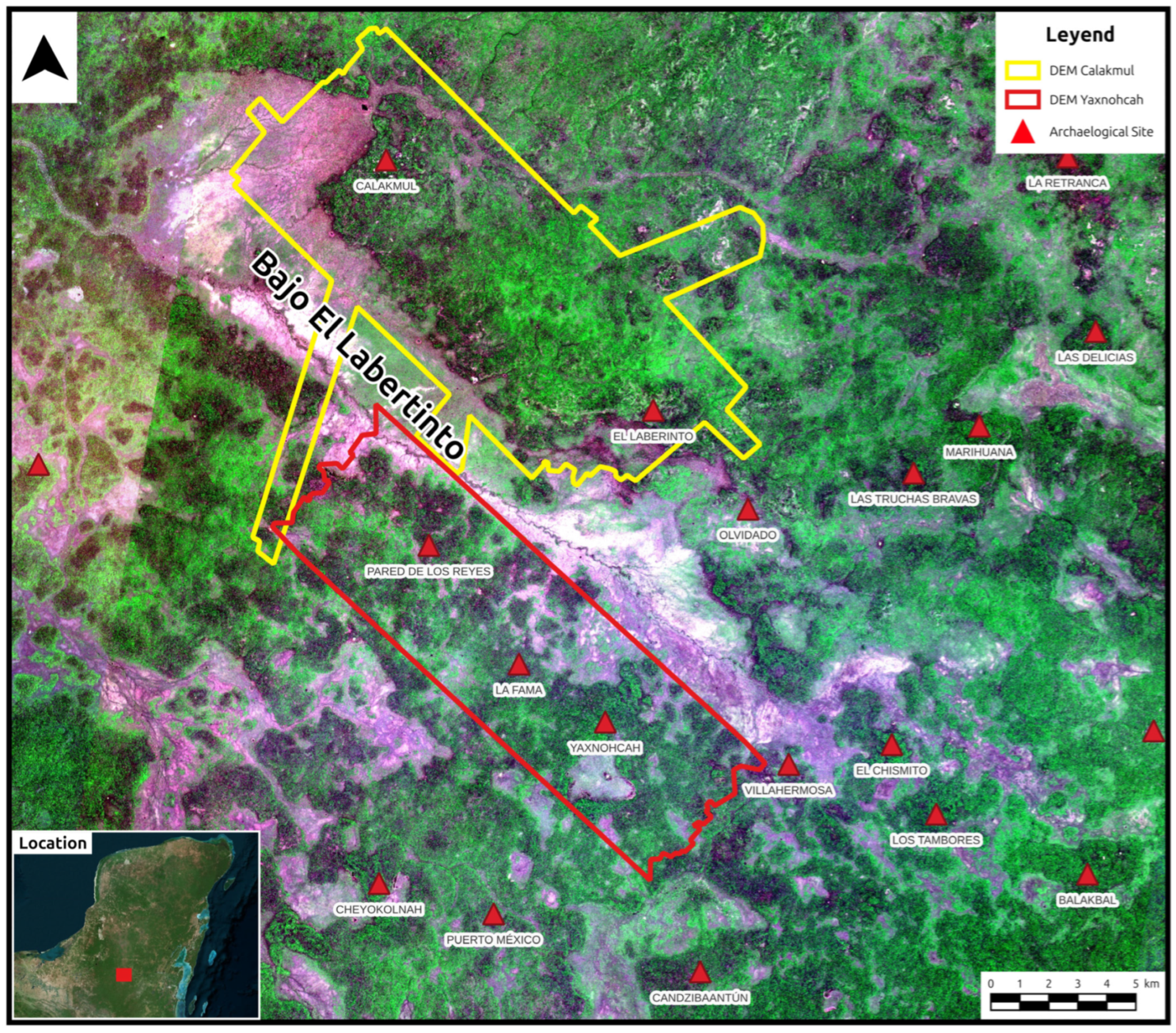
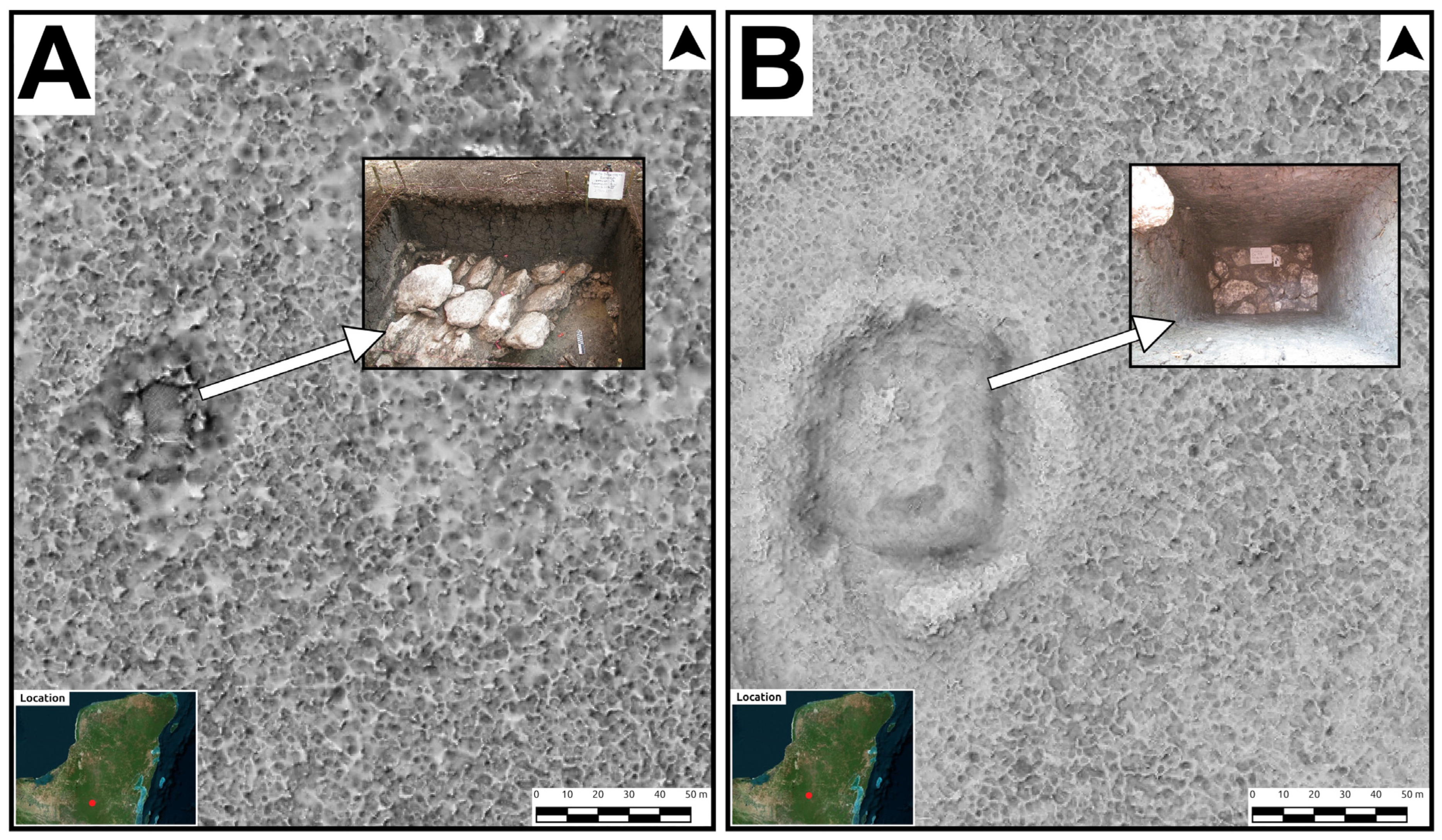
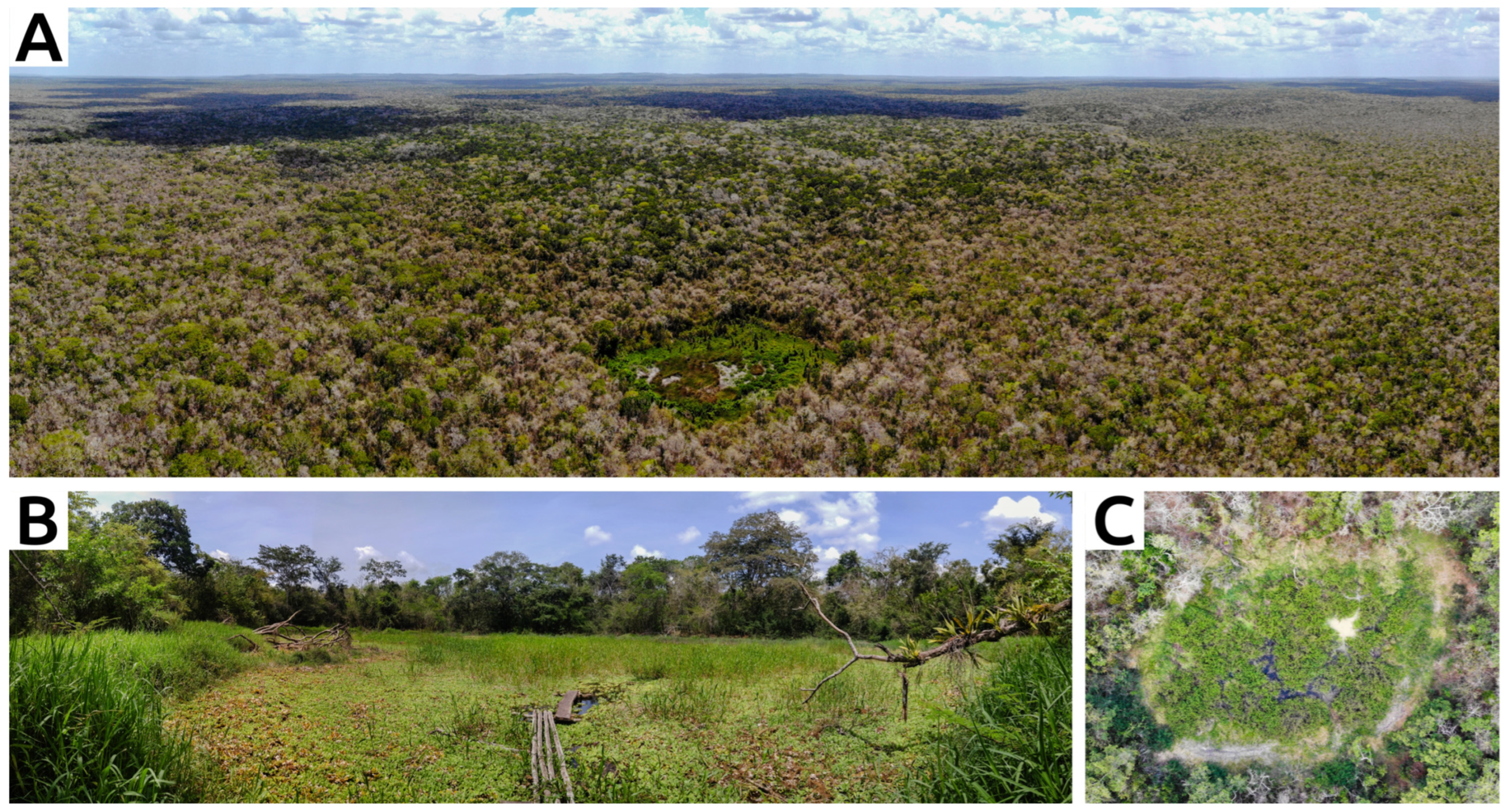
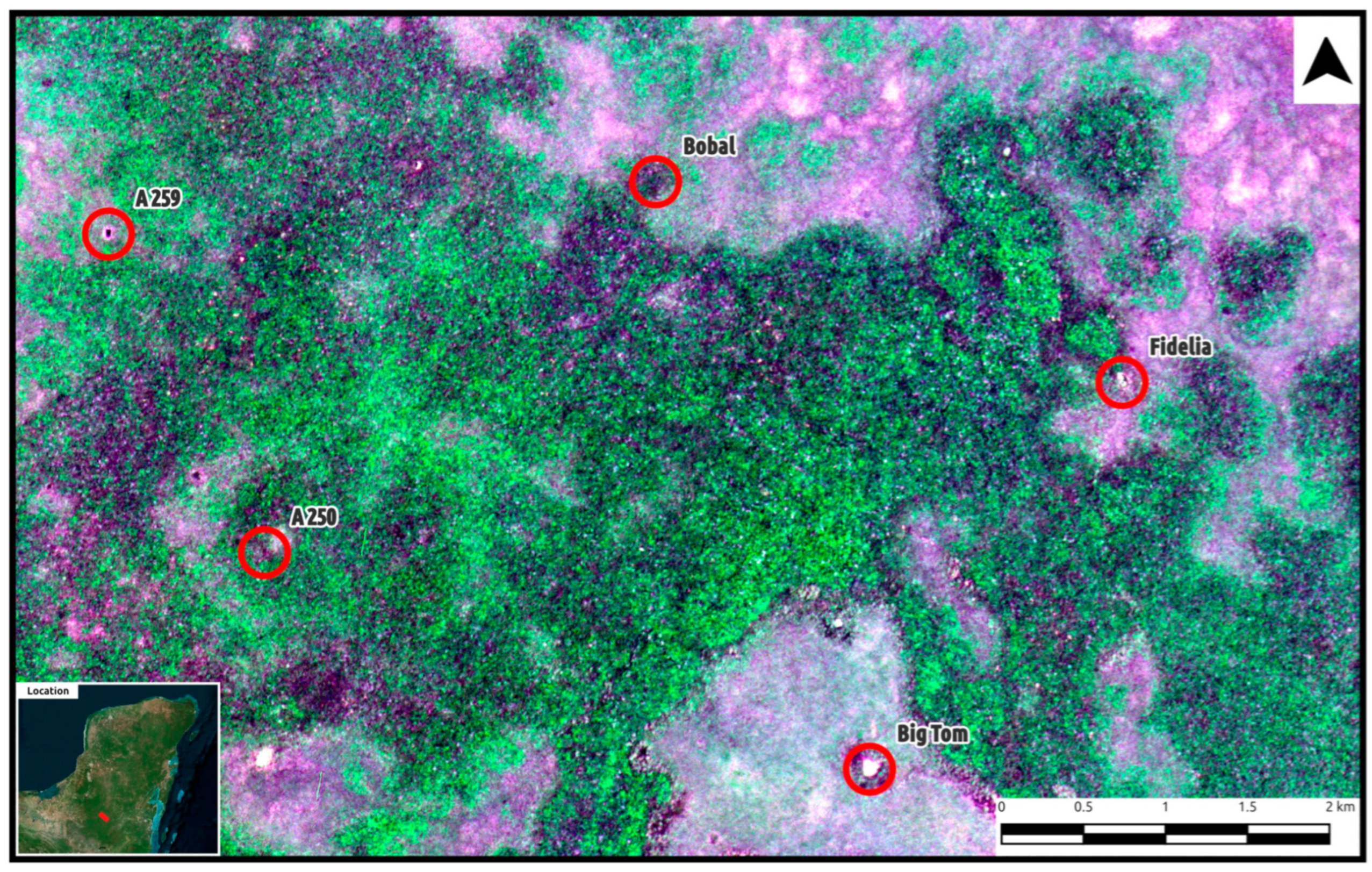



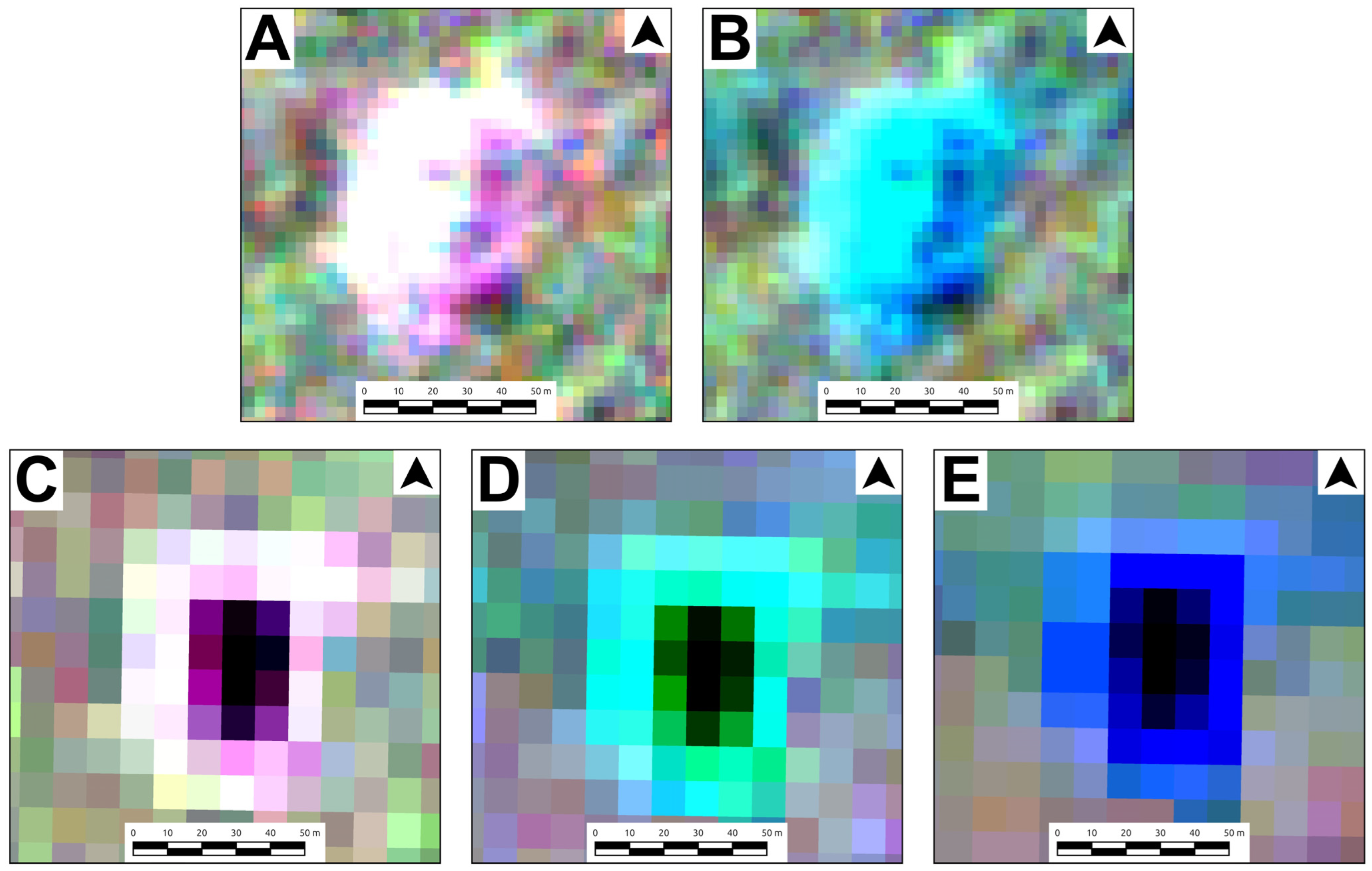

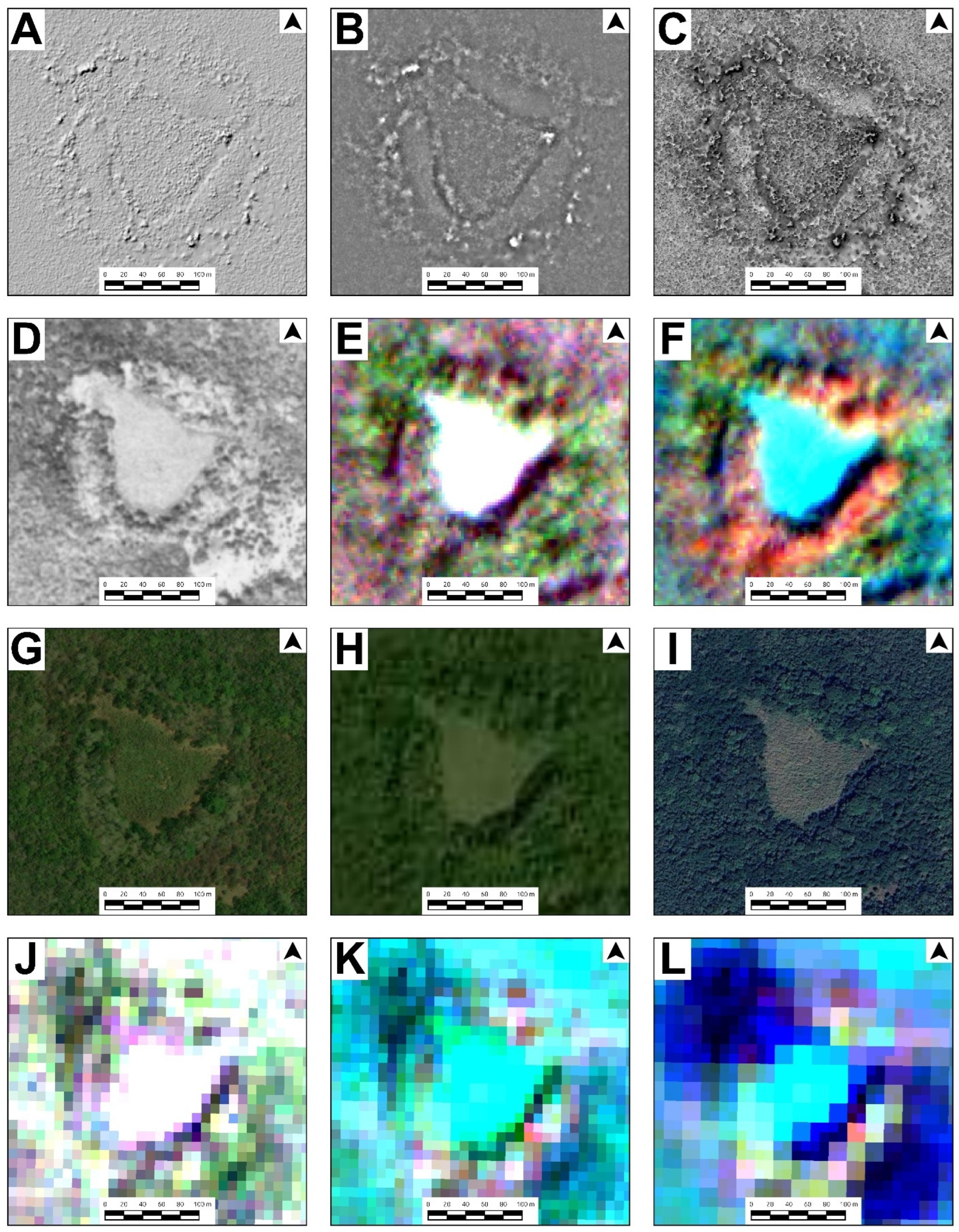

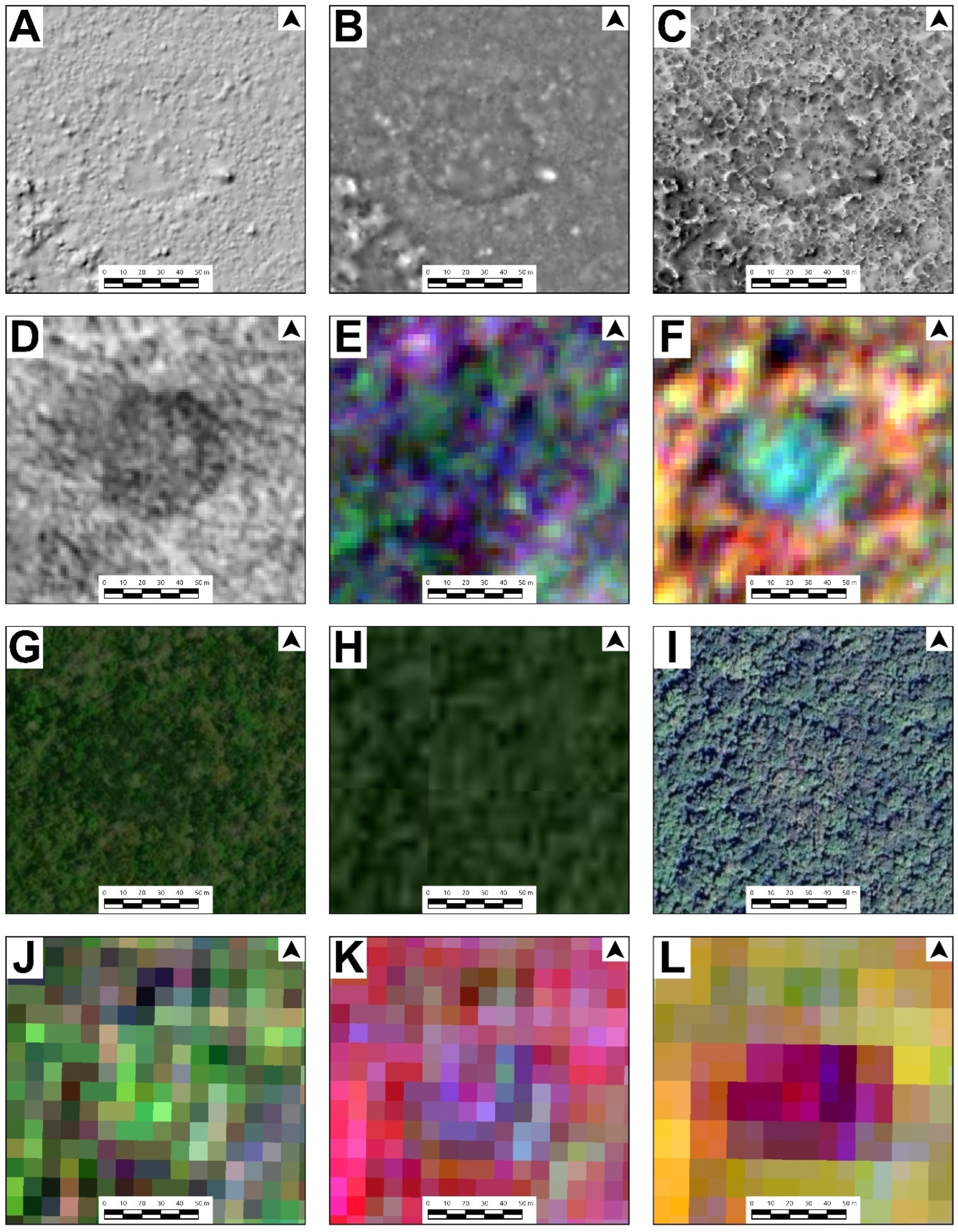
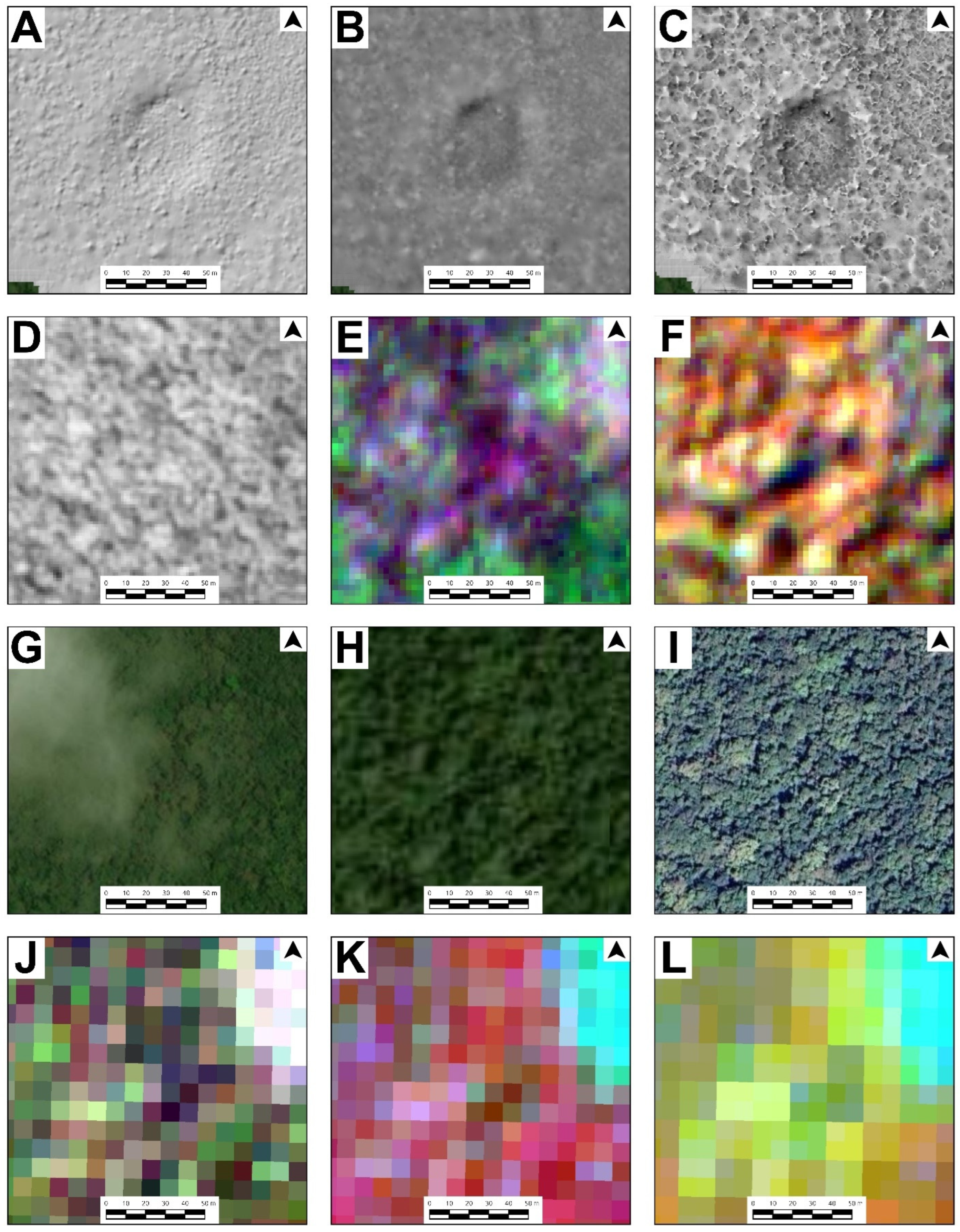
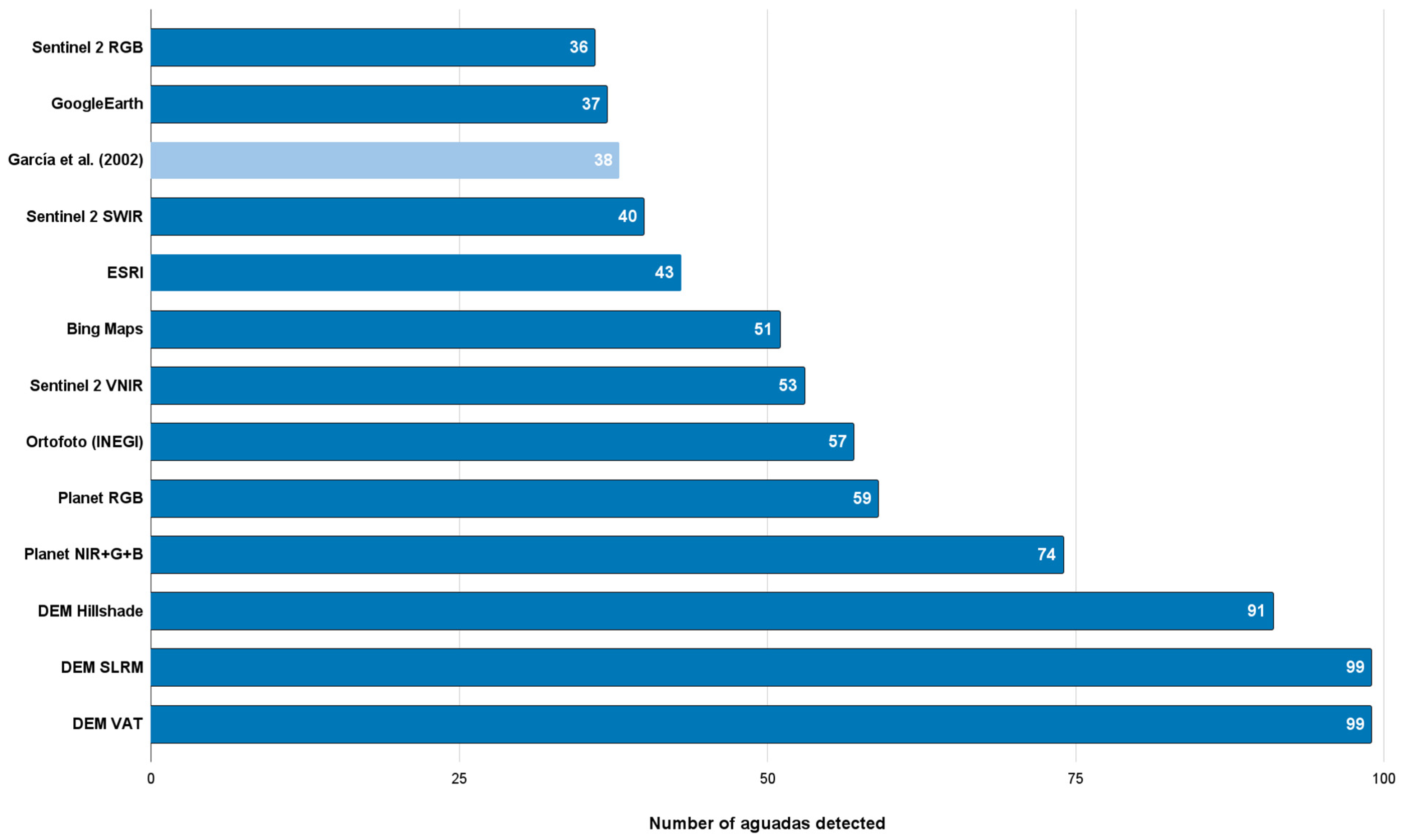
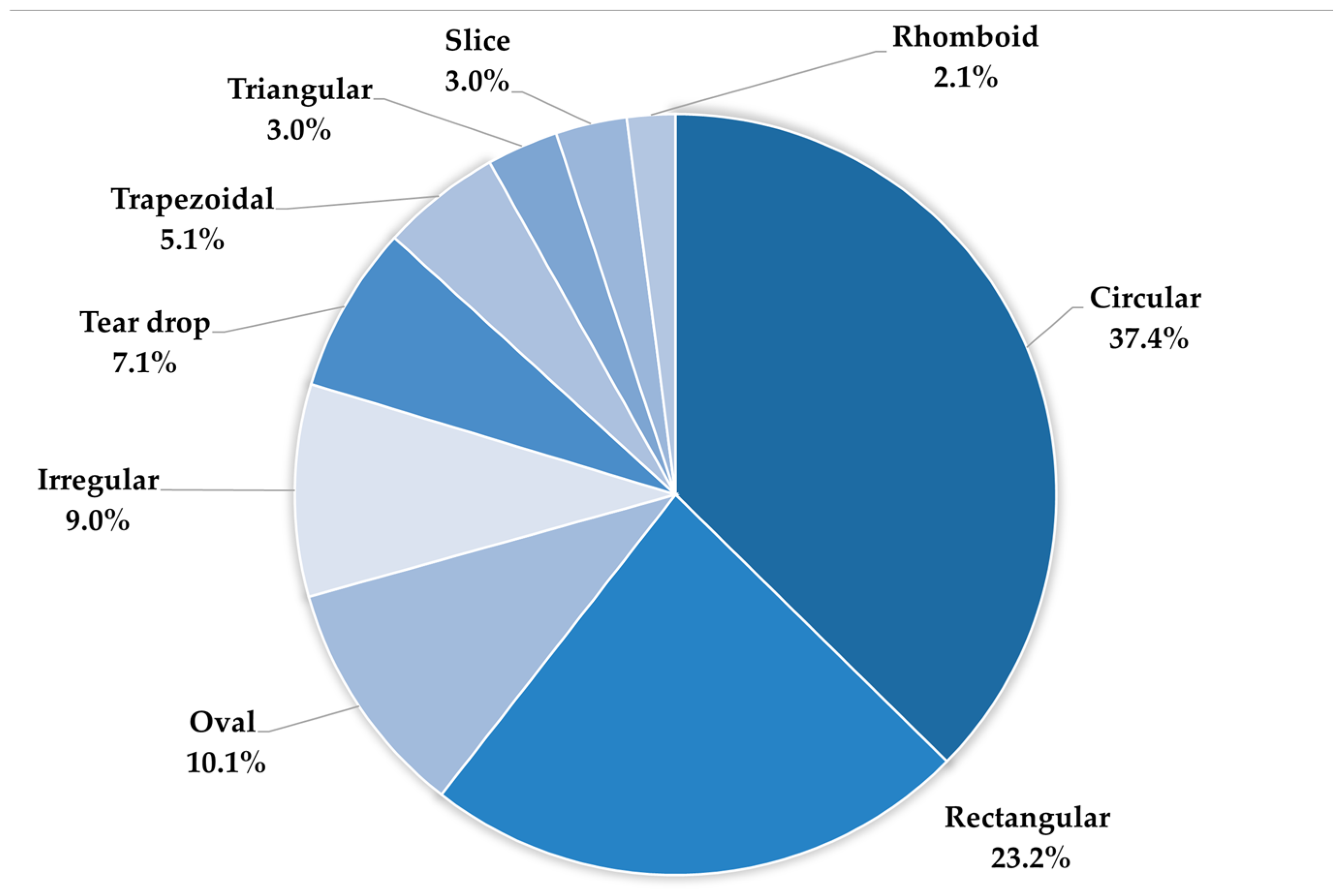
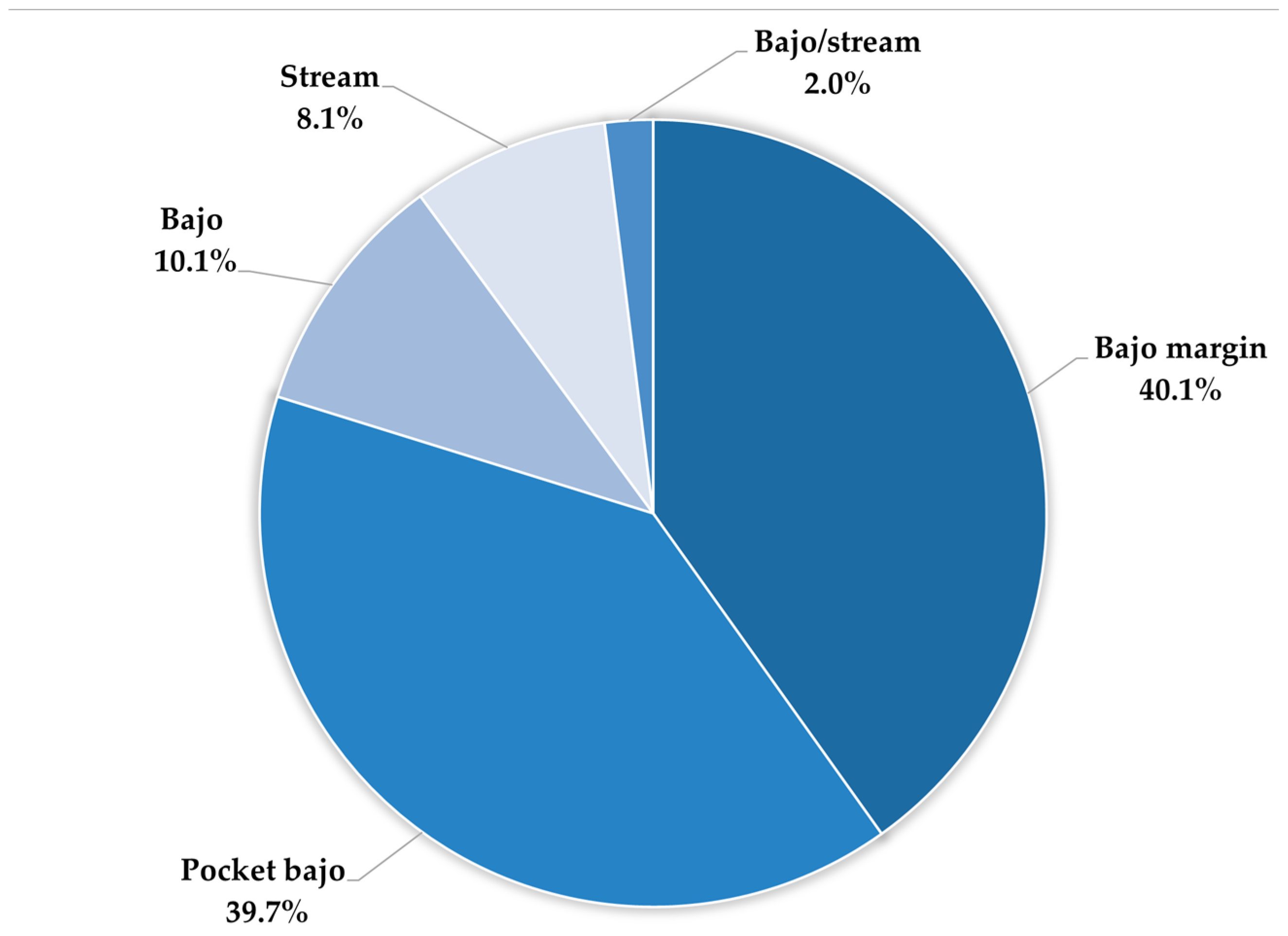

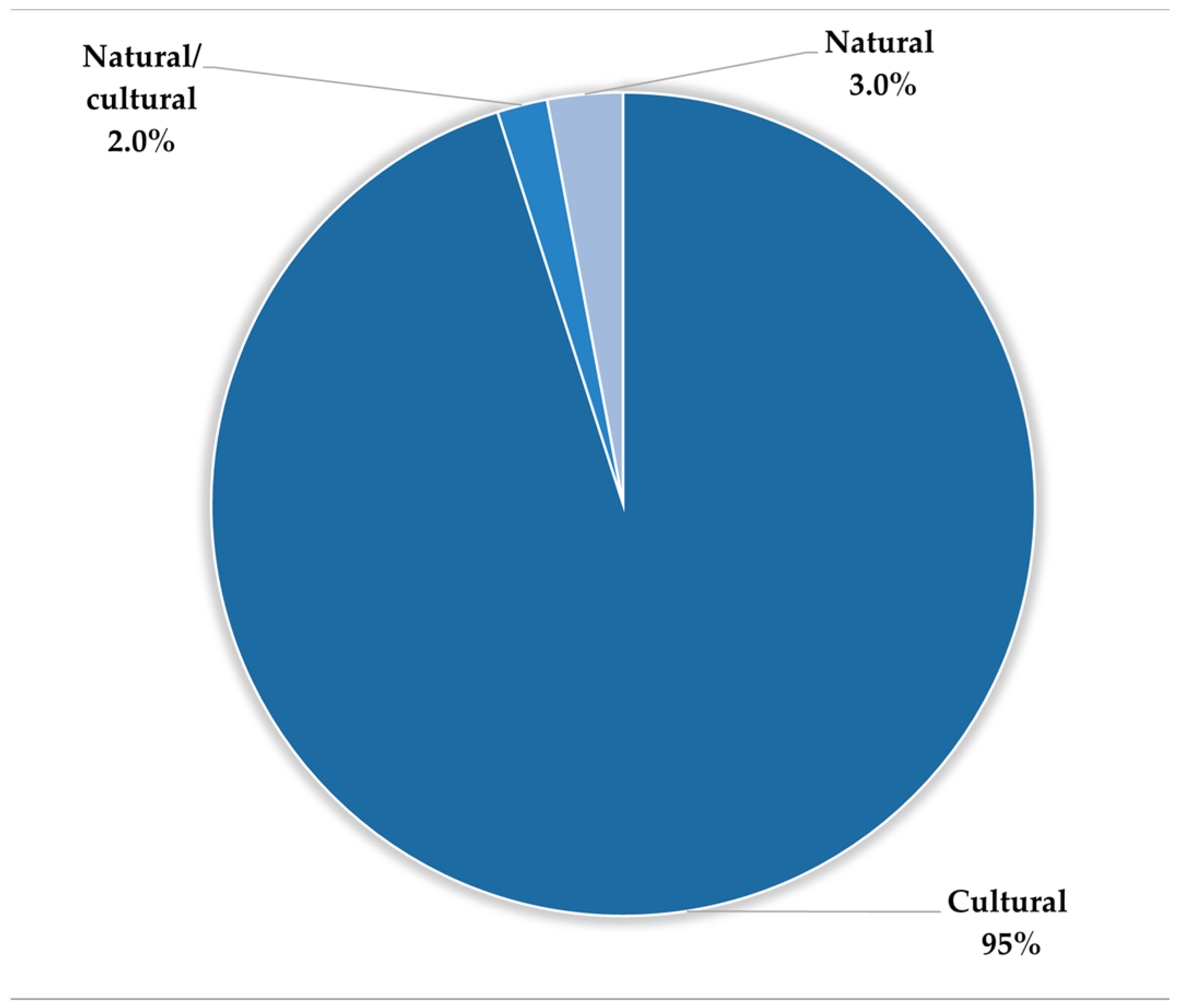
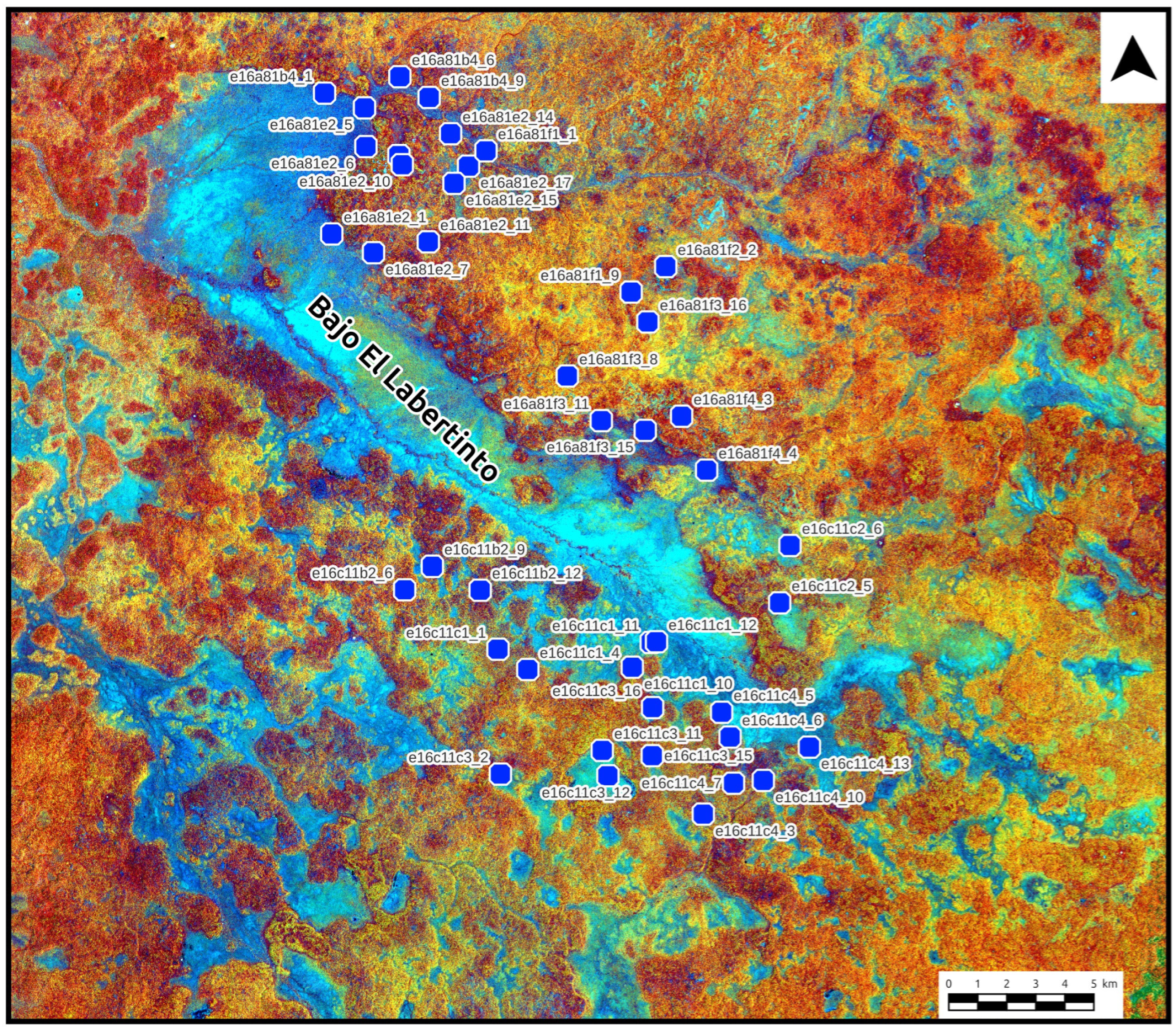
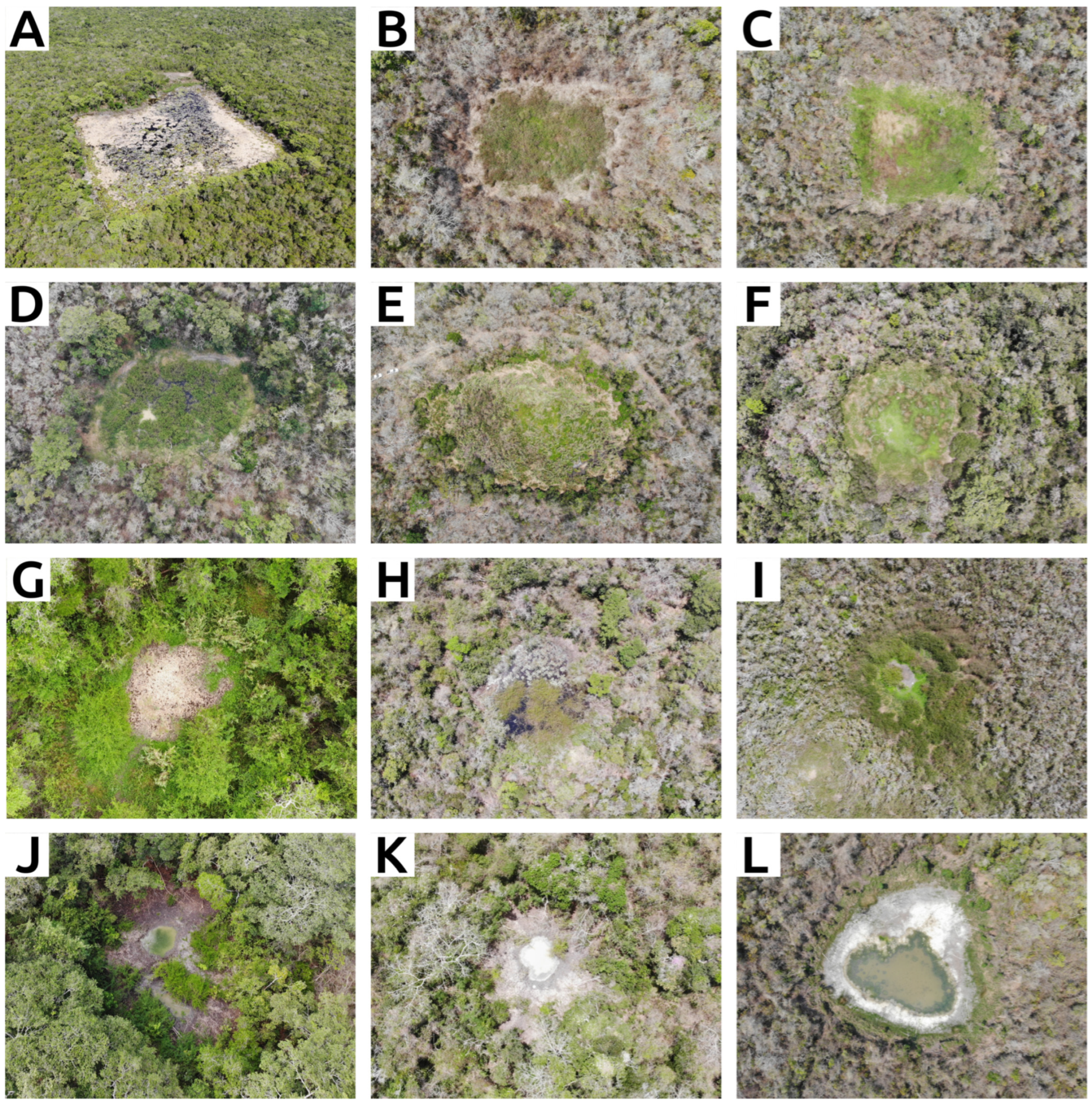
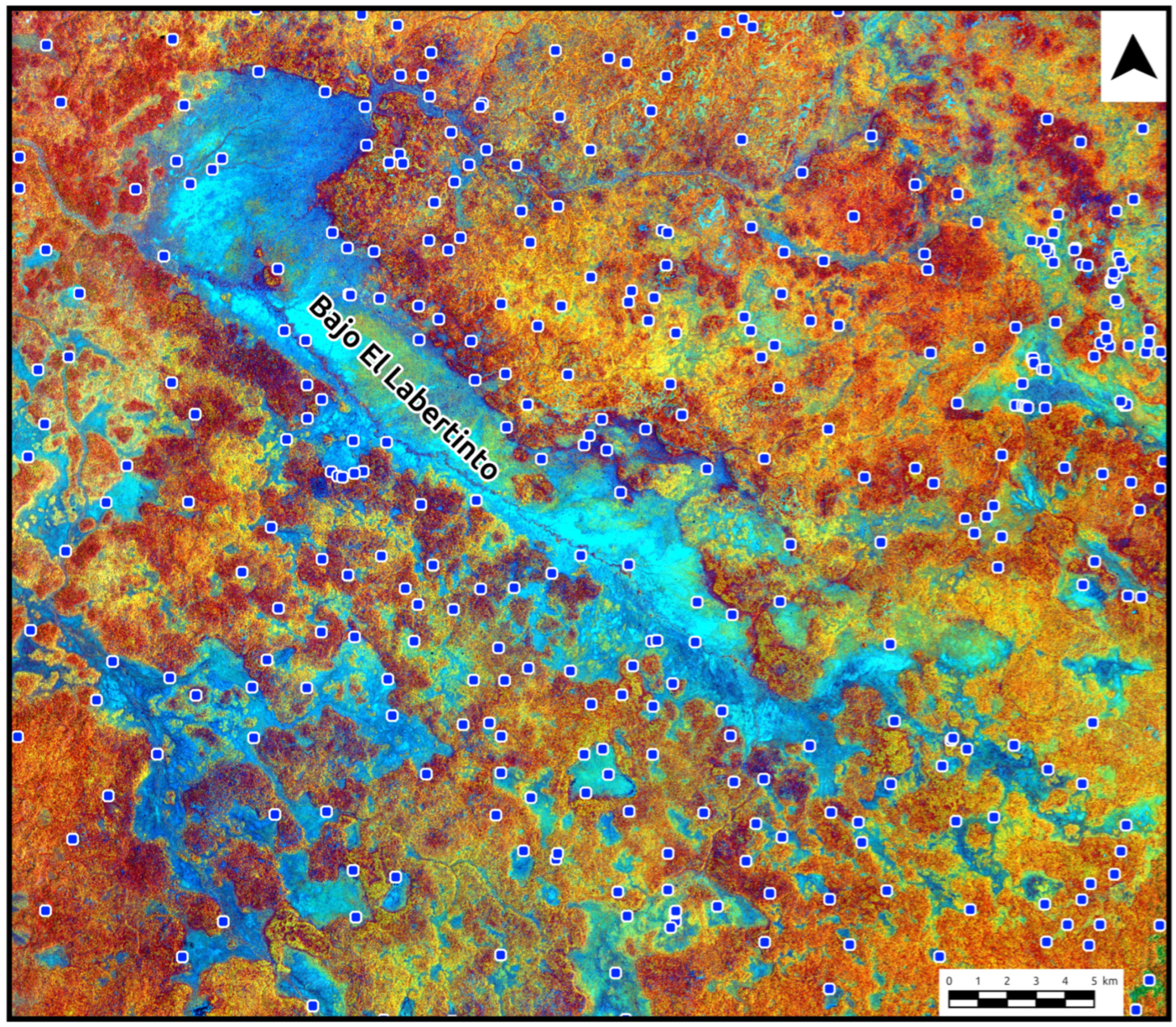
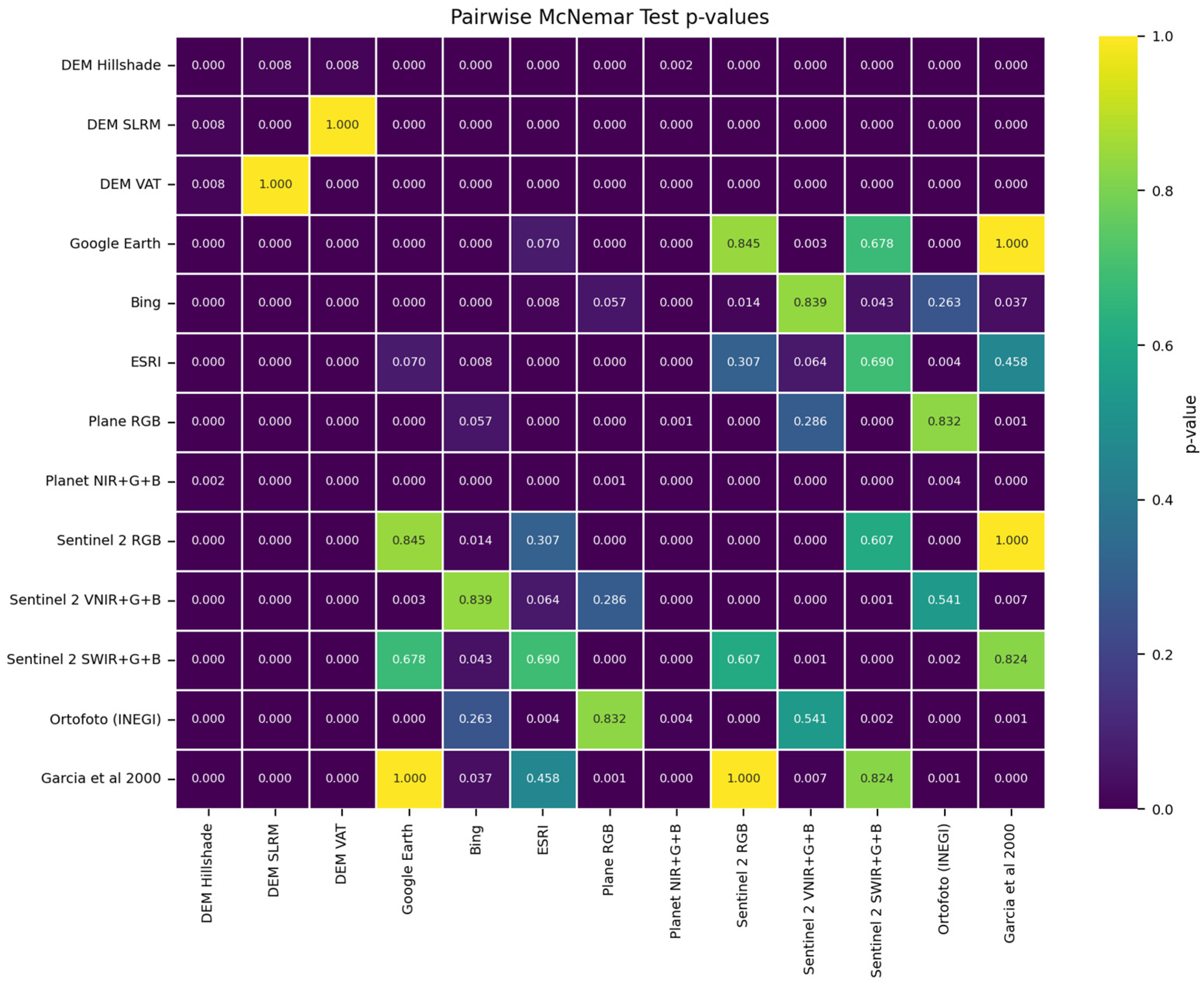
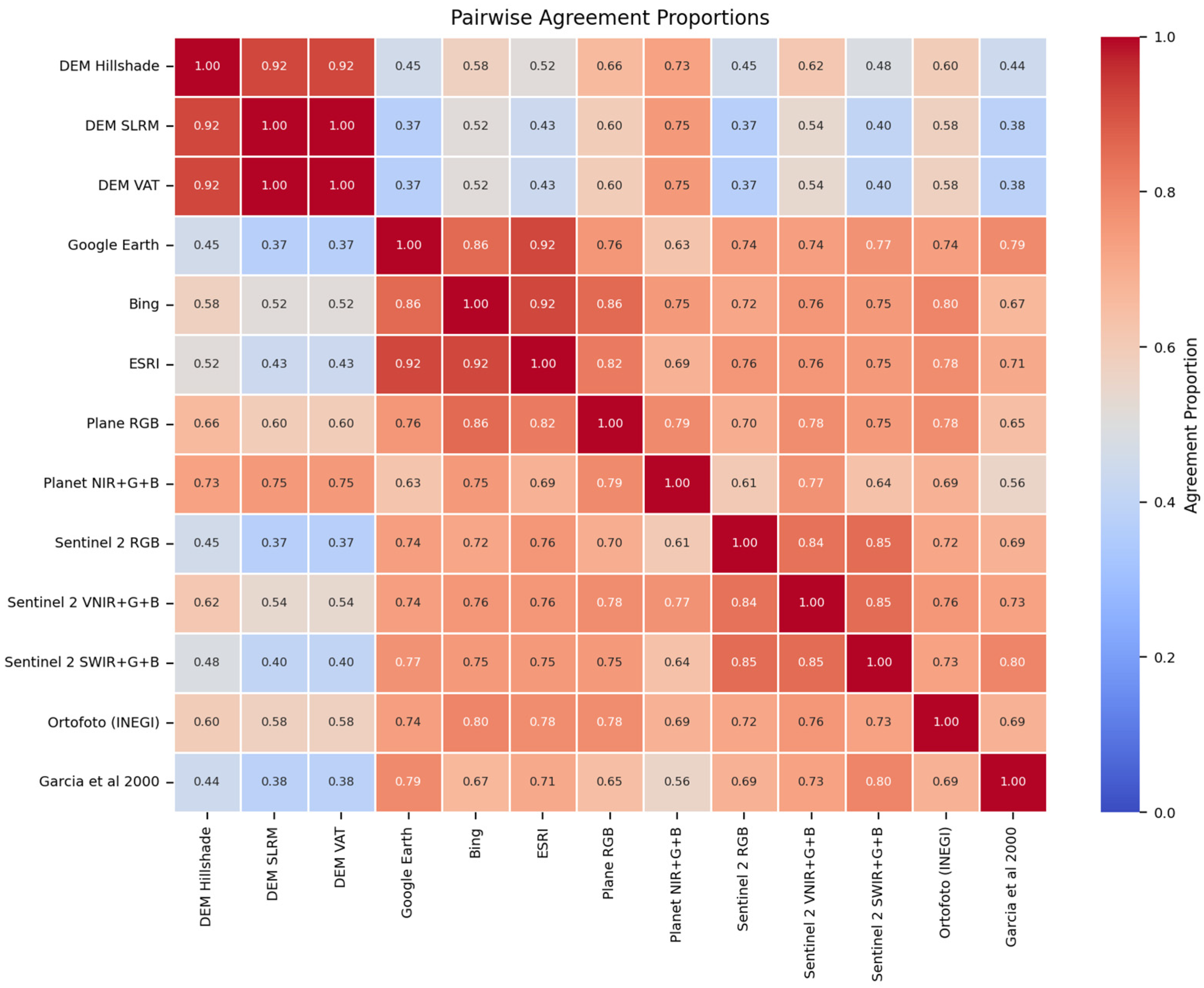
| Author (s) | Concept |
|---|---|
| Dunning et al. [58] | Ponds |
| Arredondo-Figueroa and Flores-Nava [59] | Shallow ground depressions |
| Cervantes et al. [60] | Sinkholes and shallow water reservoirs |
| Wahl et al. [8] | Small ponds associated with topographic depressions |
| Akpinar [45]; Beach [61] | Small dissolution sinkholes |
| Lohse [62] | Depressions currently holding water |
| Seefeld [50] | Ponds that retain water |
| Serrano and Weston [3] | Temporary and/or permanent body of water of natural or Prehispanic cultural origin, which is formed from rainwater, with biophysical characteristics that allow impermeability of the karstic soils of the Selva Maya. |
| Source | Type of Imagery | Sensor Type | Spatial Resolution | Bands | Access |
|---|---|---|---|---|---|
| lidar (PABEL) | Lidar-derived DEM | Active | 50 cm | Point cloud | Cost (private) |
| INEGI | Orthophoto | Passive | 1.5 m | - | Free |
| Bing Maps | RGB Mosaic | Passive | 4.5 m | - | Free |
| ESRI | RGB Mosaic | Passive | 60 cm–15 m | - | Free |
| Google Earth | RGB Mosaic | Passive | 60 cm–30 m | - | Free |
| Sentinel-2 | Multispectral | Passive | 15 m | 13 | Free |
| Planet | Multispectral | Passive | 3 m | 4 | Cost (courtesy) |
| Name | Figure | INEGI Name-Based | Form | Position | Canopy |
|---|---|---|---|---|---|
| Aguada 259 | 5–8 | e16c11c3_3 | Oval | Pocket bajo | Cover |
| Aguada 250 | 13 | e16c11b2_11 | Irregular | Bajo margin | Open |
| Big Tom | 10 | e16c11c3_12 | Triangular | In bajo | Open |
| Bobal | 12 | e16c11c1_6 | Circular | Bajo margin | Cover |
| Fidelia | 11 | e16c11c3_16 | Tear-drop | Pocket bajo | Cover |
| Source | A 250 | A 259 | Big Tom | Bobal | Fidelia |
|---|---|---|---|---|---|
| DEM Hillshade | ✓ | ✓ | ✓ | X | ✓ |
| DEM SLRM 20 | ✓ | ✓ | ✓ | ✓ | ✓ |
| DEM VAT | ✓ | ✓ | ✓ | ✓ | ✓ |
| Orthophoto (INEGI) | X | ✓ | ✓ | ✓ | ✓ |
| GoogleEarth | X | ✓ | ✓ | X | |
| BingMaps | X | ✓ | ✓ | X | ✓ |
| ESRI | X | ✓ | ✓ | X | ✓ |
| Planet RGB | X | ✓ | ✓ | ✓ | ✓ |
| Planet NIR+G+B | X | ✓ | ✓ | ✓ | ✓ |
| Sentinel 2_RGB | X | ✓ | ✓ | X | ✓ |
| Sentinel 2_NIR+G+B | X | ✓ | ✓ | X | ✓ |
| Sentinel 2_SWIR+G+B | X | ✓ | X | X | ✓ |
Disclaimer/Publisher’s Note: The statements, opinions and data contained in all publications are solely those of the individual author(s) and contributor(s) and not of MDPI and/or the editor(s). MDPI and/or the editor(s) disclaim responsibility for any injury to people or property resulting from any ideas, methods, instructions or products referred to in the content. |
© 2025 by the authors. Licensee MDPI, Basel, Switzerland. This article is an open access article distributed under the terms and conditions of the Creative Commons Attribution (CC BY) license (https://creativecommons.org/licenses/by/4.0/).
Share and Cite
Flores Colin, A.G.; Dunning, N.P.; Anaya Hernández, A.; Carr, C.; Kupprat, F.; Reese-Taylor, K.; Hinojosa-Garro, D. Detection of Aguadas (Ponds) Through Remote Sensing in the Bajo El Laberinto Region, Calakmul, Campeche, Mexico. Remote Sens. 2025, 17, 3299. https://doi.org/10.3390/rs17193299
Flores Colin AG, Dunning NP, Anaya Hernández A, Carr C, Kupprat F, Reese-Taylor K, Hinojosa-Garro D. Detection of Aguadas (Ponds) Through Remote Sensing in the Bajo El Laberinto Region, Calakmul, Campeche, Mexico. Remote Sensing. 2025; 17(19):3299. https://doi.org/10.3390/rs17193299
Chicago/Turabian StyleFlores Colin, Alberto G., Nicholas P. Dunning, Armando Anaya Hernández, Christopher Carr, Felix Kupprat, Kathryn Reese-Taylor, and Demián Hinojosa-Garro. 2025. "Detection of Aguadas (Ponds) Through Remote Sensing in the Bajo El Laberinto Region, Calakmul, Campeche, Mexico" Remote Sensing 17, no. 19: 3299. https://doi.org/10.3390/rs17193299
APA StyleFlores Colin, A. G., Dunning, N. P., Anaya Hernández, A., Carr, C., Kupprat, F., Reese-Taylor, K., & Hinojosa-Garro, D. (2025). Detection of Aguadas (Ponds) Through Remote Sensing in the Bajo El Laberinto Region, Calakmul, Campeche, Mexico. Remote Sensing, 17(19), 3299. https://doi.org/10.3390/rs17193299







